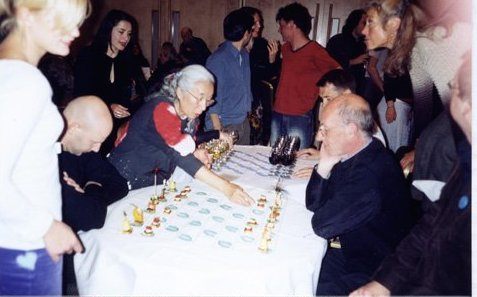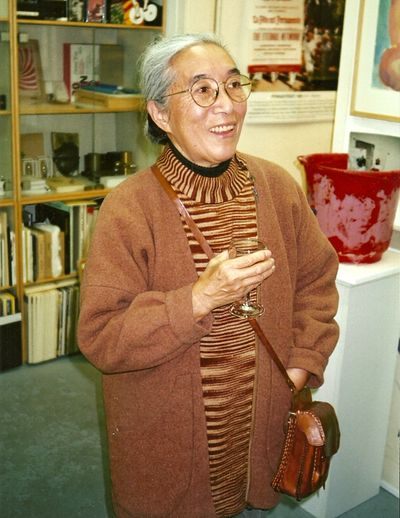Object Of Intrigue: Chess You Play With Your Nose

Now just trade your stove in for a chessboard and you’re good to go. (Photo: Brianna Lehman/Flickr)
The game is a few steps away from checkmate. The players are hunched over the board, breathing hard. Queen to h7–a rush of cayenne! Knight to h8–a burst of ginger! The final moves rain down in a sinus-cleansing flurry of clove and turmeric. This isn’t regular chess. This is Spice Chess, and in Spice Chess, victory smells not sweet, but interesting.
Spice Chess, which looks like a chessboard populated by corked vials, is a game-slash-philosophy invented by the Japanese-American Fluxus artist Takako Saito. Saito’s many chess sets–which also include Sound Chess, Weight Chess, Book Chess, and more–“transformed the ultimate conceptual game into a play of sensuous interactions,” writes art historian Midori Yoshimoto. In them, Saito used beautiful objects to animate even more beautiful ideas.

Sound Chess, from 1965, is made up of visually identical wooden boxes, differentiated only by noisemakers hidden inside–rather than sporting horse heads, each white knight rattles with a single corn kernel, and the black queen announces her movements with the jangle of several bells. To play Weight Chess, from the same year, requires carefully hefting virtually indistinguishable boxes of slightly different weights. Spice Chess, the best-known member of the Flux Chess family, features pawns filled with cinnamon and cayenne pepper queens.
There is also Liquid Chess (bottles of different-smelling potions), Wine Chess (various red and white wines in full-sized wine glasses), Book Chess (different tiny texts), and Canapé Chess (self-explanatory, but a bit messy). If normal chess rewards a narrow focus and a strategic memory, Flux Chess instead requires a certain worldly sensitivity before you even make a move–as Yoshimoto puts it, “you play by imagination and mistake.”
Video from the Tate Modern’s 2008 Flux Olympiad.
Takako Saito spent the first half of her life in Japan, where she was a free-spirited child and, eventually, a free-spirited schoolteacher–she prized individual autonomy over regimented study, and would let her pupils skip class to play baseball. Led by these enthusiasms, she became an art educator and then an artist, moving around Japan and working odd jobs to support her projects. In 1964, at age 35, she learned English and made a bigger leap–all the way to New York, following some of her art world friends who had already made good.
Here, Saito met George Maciunas, an artist and critic trying to lift a movement off the ground. Inspired by the artists he admired, like John Cage and Marcel Duchamp, Maciunas had founded a network he called Fluxus. Rather than stringent artistic goals or pricey final pieces, Fluxus emphasized the process of creating–the “flux.” Fluxus members staged events, acted out mundane activities, and mass-produced handmade objects. Like free-spirited schoolteachers, they encouraged spectator participation.
Just after she arrived in New York, Saito met Maciunas, and the two got on like gangbusters. Each saw in the other someone who would give up anything for art–Saito had left her job, her family, and her homeland, and Maciunas, a notorious control freak, had damaged many of his personal relationships. This also meant he needed extra hands, and Saito was more than willing to lend her very talented ones.

Saito takes on a fellow Fluxus partygoer in a game of Canapé Chess. (Photo: Courtesy Armin Hundertmark)
Soon, they were spending most days working together to craft Fluxus objects and publications. Despite his reputation, Maciunas gradually handed over more and more aesthetic control to Saito, who was a skilled carver with a great sense of design. In the evenings, they’d head to a carousel of Fluxus dinner parties, most of which ended in fierce chess matches. Late in 1964, Maciunas suggested they combine these pursuits–Saito, he said, should design and build a unique chess set for the Fluxus movement. They could call it “Flux Chess.”
Flux chess became, as Yoshimoto puts it, “a lifelong obsession” for Saito. Her first set, Nut & Bolt Chess, has pieces made of construction materials, each of which can be screwed into holes in the board–a step removed from aristocratic knights-and-pawns gameplay, but nothing too fundamentally strange. Quickly, though, she began putting together boards and pieces that were more than just redesigns. Saito’s slightly later pieces don’t just mess with chess–they realign the entire experience, replacing sight with other, underutilized senses, and closed-box logic with more open forms of understanding.

Takako Saito at a Fluxus show in 1986. (Photo: Courtesy Armin Hundertmark)
Back in the 1960s, you could order your chess of choice from the Fluxus mail-order catalogue. These days, though, playing it requires a different type of creativity. Most of the original sets are locked up in art museum basements or stuck behind Plexiglass, says Yoshimoto–when she curated a Fluxus retrospective a few years ago, she had to make her own Sound Chess set. Saito herself now lives in Dusseldorf, where she has spent the past few years focusing on non-chess projects. She and her contemporaries don’t get out much anymore. “It’s kind of the tail end of the viable, interesting Fluxus,” says Yoshimoto.
Spice Chess and its official fellows may be relegated to dusty museums. But where there’s a cabinet and two willing noses, there can always be Spice Chess. Your move.
Gastro Obscura covers the world’s most wondrous food and drink.
Sign up for our regular newsletter.
































Follow us on Twitter to get the latest on the world's hidden wonders.
Like us on Facebook to get the latest on the world's hidden wonders.
Follow us on Twitter Like us on Facebook